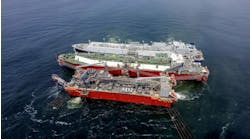William G. HiggsObviously, there is a boom in the oil patch. How we react to the increased work available will determine our long term success. Companies as well as individuals will be faced with a myriad of decisions. Due to this boom type environment, the number of decisions and the pace at which they become critical is increasing. In order to make decisions in a fast paced environment and gain long term success, we need to understand the larger picture. We need to review the vision, goals and course of action that took us through the tough times and figure out how to 'stay the course' in a time of plentiful work.
Mustang Engineering, Inc.
Companies that survived the lean years are people oriented. This people orientation extended beyond company boundaries to include suppliers and clients. Through attrition, it became obvious that if we were to survive, it would be as an integrated team.
- We learned to value supplier personnel's judgment and ability to help find solutions.
- We learned how to take care of clients and help them, as individuals, survive within tough, demanding work environments.
The credo during this time could have been 'steady work for steady people.' All company systems were geared toward keeping the best people and finding enough work to keep them profitably employed. Everyone took good care of their clients in order to ensure future work.
Clients demanded top performance for their dollar. Experienced people were the only answer. We took good care of performers in order to reduce turnover and increase team capability. This ability to keep key people was critical in order to meet aggressive project targets for price and schedule.
These aggressive project targets severely restricted the things companies and individuals could do during this time to set up for long term success.
- Companies could not bring in young people for training. Due to the restricted market, there was a barrier to people entering the industry - tight budgets and schedules required seasoned performers.
- Flat or regressing wages caused the future to look dim in the near term for people in this industry. Additional training for personnel was curtailed. Generally, company bottom lines could not afford training costs.
- Companies had a lean staff that was worked hard because margins were thin. This hard working environment did not allow time for training.
- Companies and people did not have the luxury of working only the types of projects they wanted. They could not pick types of work that best suited them, or that would move them in a strategic direction. Companies had to chase everything possible and figure out how to handle what they received. Although this environment may have increased company and personnel flexibility, it did not allow for any long range planning.
The current expansion of projects available provides a significant opportunity for companies and people to change the environment depicted above. However, we need to change this environment in a steady, restrained manner. We can only be steady through good communications and planning.
During the lean years, companies downsized to the point where people from top to bottom in the organization got to know each other well. We understood that we could only survive by pulling together as a team. The 'best player played' whether it was the president doing a calculation or a designer buying a piece of equipment. The attitude was 'just do it,' and get on to the next task. Communication lines were very short and decisions happened at the lowest level.
Now, with the influx of new people and more projects, communications lines are being diluted. Company management absolutely needs the steady players that helped them through the tough times to stay on board and take all areas to a new level. These players need to keep the 'just do it' attitude and teach new people how to keep communication lines short. It is incumbent on both management and personnel to continue communicating their vision, needs, and goals.
These needs and goals now must be worked into plans. People and companies still need to react well, but there is time to plan and set up for a better future.
- Young people must be recruited and set up with 'mentors' so that they can be productive. A well planned mentor system will increase their value to the company quickly and ensure they do not get lost in the busy environment.
- The old backbone of steady players must receive organization and communication training since they will have increased responsibilities. These people know the company culture, methods, and goals. They have to be able to impart this knowledge to their team, suppliers and clients.
- Companies and people must communicate the type of work they are good at, and the type of work they want to stretch into. Once understood, it is required of all parties to make the normal work more efficient, such that there is time and funding to pursue the stretch work. This will keep people and the old steady players challenged.
- When needs and goals are well communicated and planned, company and personal visions should readily align. People will not move between companies because they can find the opportunity and challenges they need within the current setting. Companies and people were able to keep steady during the lean years through good communications.
- People and companies need to resist jumping in too many directions just because there is an abundance of opportunity. The good times need to be enjoyed and transferred into our families and communities, rather than becoming a vehicle that alienates us from our families and communities. In order to do this, we need to build for long term success with steady growth and steady work for steady people.
Copyright 1997 Oil & Gas Journal. All Rights Reserved.


